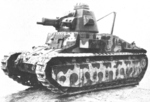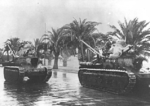Char D1
| Country | France |
| Primary Role | Light Tank |
Contributor: C. Peter Chen
ww2dbaseIn 1923, French firm Renault received an order from the French Army to create two new light tank prototypes to replace the aging FT design currently in service. One of them, NC1, was deemed the fastest tank that the French had ever developed. In 1926, the French Army issued a requirement for a new light infantry support tank, and Renault responded with a further modified version of the NC1 design that Renault designated Modèle 26/27. The submission was accepted for further development in 1928, thus internally Renault renamed the design NC28. Around this time, the French Army renamed its light infantry support tank project Char D. In Dec 1929, the Army ordered 10 prototype vehicles to be constructed for field testing, and these tanks were designated NC31 by Renault, after the intended year of delivery, 1931. On 23 Dec 1930, the first production order was issued in the quantity of 70, followed by the 12 Jul 1932 order for 30 and the 16 Oct 1933 order for 50. Designated by the Army as Char D1, they officially entered service in Jan 1932. The Char D1 tanks initially operated with the same turrets as the earlier FT tanks, but that was a temporary solution as a new turret design that would fit the new Char D1 hull was being worked on; the replacement, ST2 by the firm Schneider, began to be installed in early 1936. Much heavier than the FT turrets, a Char D1 tank null with ST2 turret had a weight of 14 metric tons, which was rather heavy for the 1930s for a fighting vehicle with a light tank designation. Thus, they were operated as a battle tank.
ww2dbaseMeanwhile, in 1928, Renault sold a NC1 prototype to Sweden (locally designated Stridsvagn fm/28), in 1930 ten prototypes to Japan (locally designated Otsu-Gata, "Type B"), and shortly after a single unit to Greece, but none of these foreign nations would issue orders in significant quantities. In 1932, the Belgian firm Cockerill expressed interest in building the latest Renault light tank design for Belgian Army use under license, but the French Army would reject this arrangement, citing military secrecy; Belgium would ultimately turn to the British firm Vickers to purchase a design.
ww2dbaseWith the French Army, the ten NC31 prototypes were used for training, while the 150 production tanks with ST2 turrets were assigned to three tank battalions, 507th, 508th, and 510th. These three battalions reported poor mechanical reliability, and by Mar 1934, out of the 110 deployed vehicles, 62 were non-operational due to various breakdowns and 17 already required factory overhauls. In 1936, it was discovered that the glass of the diascopes on the ST2 turrets would at times shatter simply from vibrations of the tanks traveling. Thus, in early 1937, they began to be removed from French Army units stationed in home, and began to be shipped to the colonial forces. They arrived in North Africa later in 1937 as the main vehicles for three new tank battalions, 61st, 65th, and 67th. In May 1940, when Germany invaded France, it was decided that tanks in North Africa were to reinforce France. 43 fully operational Char D1 tanks were organized under the 67th Tank Battalion for shipment to France, arriving in early Jun 1940. On 12 Jun, the 67th Tank Battalion and 6th Colonial Infantry Division successfully repulsed the initial attack by the German 8th Panzer Division at the village of Souain, but was ultimately flanked by the Germans, losing 7 tanks. As the 67th Tank Battalion retreated southward, most of the Char D1 tanks were lost in the next two days. By 14 Jun, only four tanks remained with the 67th Tank Battalion; three of them would ultimately be destroyed by their own crews to prevent capture, and one destroyed by German aircraft. During the battle for France, the Germans captured 18 examples; they were pressed into service under the designation Panzerkampfwagen 732 (f), although there were no indication that they were actually used by the Germans in any capacity. Meanwhile, 106 Char D1 tanks that were not fully operational in May 1940 remained in North Africa. When the Allies landed in North Africa during Operation Torch, Char D1 tanks engaged with the Americans, and 14 of them were lost in combat. When the French in North Africa switched sides to join the Allies, Char D1 tanks fought during the Battle of Kasserine Pass, destroying a German Panzer IV tank. With more capable Allied tanks becoming available to the Free French forces, Char D1 tanks were phased out in favor of British Valentine tanks.
ww2dbaseBetween Jan 1931 and early 1935, a total of 160 examples were built for the French Army, including 10 prototype vehicles and 150 production vehicles. Additionally, at least 12 were built and exported to foreign forces.
ww2dbaseSource: Wikipedia
Char D1 Timeline
| 23 Dec 1930 | The French Army issued its first order of Char D1 light tanks in the quantity of 70. |
| 25 Mar 1932 | After receiving interest from the Beligum Army for a replacement of aging Renault FT tanks, Renault approached the French Army for permission to sell the NC31/Char D1 design to Belgian firm Cockerill for licensed production. |
| 21 Apr 1932 | The French Army rejected Renault's request for selling the NC31/Char D1 design to Belgian firm Cockerill for licensed production, citing military secrecy. |
| 12 Jul 1932 | The French Army issued its second order of Char D1 light tanks in the quantity of 30. |
| 16 Oct 1933 | The French Army issued its third order of Char D1 light tanks in the quantity of 50. |
SPECIFICATIONS
Char D1
| Machinery | One Renault 6.08l V4 engine rated at 74hp |
| Suspension | Vertical springs |
| Armament | 1x47mm SA34 tank gun, 2x7.5mm Reibel machine gun |
| Armor | 16-30mm sides, 10mm top, 10mm bottom, 10m suspension |
| Crew | 3 |
| Length | 5.76 m |
| Width | 2.16 m |
| Height | 2.40 m |
| Weight | 14.0 t |
| Speed | 19 km/h |
| Range | 90 km |
Photographs
 |  |  |
Please consider supporting us on Patreon. Even $1 per month will go a long way! Thank you. Please help us spread the word: Stay updated with WW2DB: |

- » The Emperor of Japan Planned to Honor WW2-era Japanese POWs in Mongolia (4 Jul 2025)
- » US State Lawmaker John Winter Caught Using Racial Slur "Jap" and Apologized (11 Jun 2025)
- » Köln/Cologne Evacuated After Discovery of WW2 Bombs (4 Jun 2025)
- » Race, Holocaust, and African-American WW2 Histories Removed from the US Naval Academy Library (7 Apr 2025)
- » US Government Plans to Purge WW2 Information (17 Mar 2025)
- » See all news
- » 1,178 biographies
- » 337 events
- » 45,089 timeline entries
- » 1,245 ships
- » 350 aircraft models
- » 207 vehicle models
- » 376 weapon models
- » 123 historical documents
- » 261 facilities
- » 470 book reviews
- » 28,480 photos
- » 365 maps
Fleet Admiral Chester W. Nimitz, 16 Mar 1945
Please consider supporting us on Patreon. Even $1 a month will go a long way. Thank you!
Or, please support us by purchasing some WW2DB merchandise at TeeSpring, Thank you!